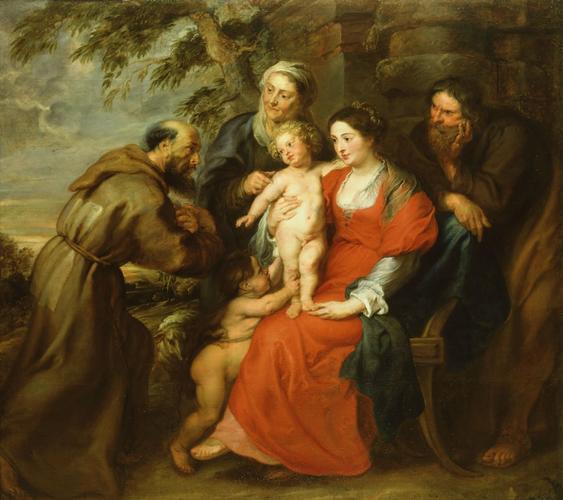-
1 of 253523 objects
The Holy Family with Saint Francis 1620-30
Oil on canvas | 191.5 x 214.0 cm (support, canvas/panel/stretcher external) | RCIN 407674
-
This scene shows the Christ Child standing on the lap of the Virgin, who sits with her mother, St Anne, and husband, St Joseph, behind. The Christ Child is worshiped by the infant St John the Baptist and St Francis, whose curious cross-handed gesture may be intended to display the wounds on the stigmata as a pledge of his devotion.
Technical examination reveals a complex evolution for this and other related paintings all probably happening c. 1626-30. Rubens originally painted this composition on a smaller piece of canvas – lacking at strip across the bottom 45 cm high (everything from just below St Francis’s right knee). While working Rubens began with the Christ Child facing his mother (in a composition almost identical to the Holy Family of c. 1626 in the Prado which was ‘on the go’ at the same time) and then turned him to face St Francis, while making many other smaller changes. Then Rubens stitched on the lower strip of canvas and added the infant John the Baptist, making room for him by pushing back St Francis’s legs. Probably at this moment Rubens generated another painting (Metropolitan Museum, New York) closely based on this final design, but also exhibiting changes. These three paintings (in the Prado, Metropolitan Museum and this one in the Royal Collection) are all autograph Rubens of the finest quality. This way of working was typical of Rubens’s breakneck creativity: he often changed poses mid-stream, allowed canvases and panels to grow while working on them and lit his next cigarette off the butt of the previous one.
To make things more complicated still when in the collection of George I a huge 60 cm strip was added to the top of the canvas; William Kent designed the frame (executed by James Richards in 1723-4) and the painting hung over the fireplace in the Great Drawing Room at Kensington Palace. It was very common at this date to adjust old masters in this way to make them ‘grander’ or to fit particular spaces, involving anonymous artists painting substantial areas ‘to match’. This canvas and frame have subsequently been reduced to reflect Rubens’s original (or rather final) design, as opposed to the demands of Georgian interior decoration.
In addition to being a fine autograph Rubens, this work is in excellent condition and preserves the subtle colour and lighting which is a feature of Rubens’s art, especially at this late date. The objects are set within a broad colour spectrum of brown to blue, the man-made colours (in this case draperies) almost bleeding into the natural colours of the landscape, with the red of the Virgin’s dress as a climactic intensification of the warm browns all around it. This brown-blue spectrum evokes the separation of light seen literally in the evening sky in the background, as if the figures are clothed in a heavy coloured atmosphere of dusk. No painting by Rubens allows us to uderstand the contradictory character of his reputation more clearly. He was a known admirer of Raphael (Bellori) and this work is clearly intended to be an essay in the sweet tenderness of Raphael’s Holy Families, in particular recalling The Holy Family of Francis I (Louvre) of 1518, which Rubens could have seen in the French royal collection. On the other hand the blushing, flesh-and-blood wobbliness of his figures were qualities actively discouraged by the Academy.
It was these characteristics of sensuality, atmosphere and vivid, breathing realism that inspired artists on the margins of the Academy, like Watteau and Delacroix.
The painting appears in Pyne's illustrated Royal Residences of 1819, hanging in the King's Drawing Room at Windsor Castle (RCIN 922107).
Text adapted from The First Georgians: Art and Monarchy 1714-1760, London, 2014.Provenance
Probably bought by George I from Mr Law(s) in 1723
-
Creator(s)
Acquirer(s)
-
Medium and techniques
Oil on canvas
Measurements
191.5 x 214.0 cm (support, canvas/panel/stretcher external)
262.4 x 275.0 x 12.8 cm (frame, external)
Category
Object type(s)
Other number(s)
